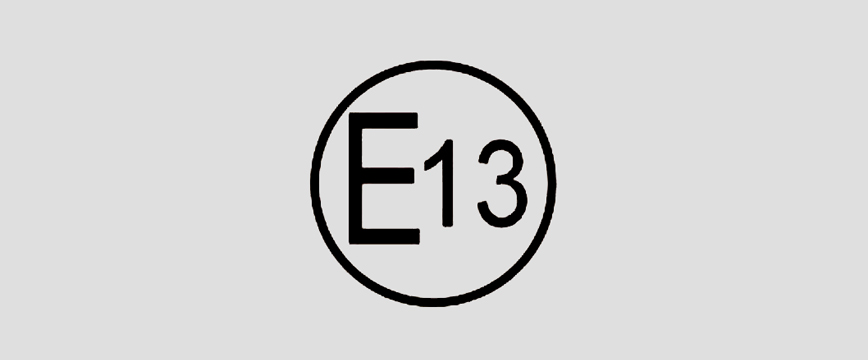E/e-Mark is a certificate issued by the European Common Market for motor vehicles and their safety parts and accessories, noise and exhaust gas, etc., in accordance with European laws and regulations, to ensure the safety of vehicles and environmental protection. The product has an E/e-mark certification mark, indicating that the product meets the standard requirements. If the product does not have an E/e-mark logo, it is forbidden to be sold in the market.
The so-called E-mark is a certification of the ECE standard requirements, which is the World Vehicle Regulations Coordination Forum (WP.29) of the Inland Transportation Committee (ITC) of the UN Economic Commission for Europe (UNECE). The publications issued are generally applicable internationally. Although the export of domestic independent brand models is still mainly concentrated in countries and regions with low economic development or low technical requirements (such as Iran, the Middle East, Southeast Asia, etc.), the type approval system adopted by these countries and regions (Type Approval) Most of the technical standards are referenced to ECE regulations or directly borrowed. Therefore, research on ECE standards is of particular importance for the export of domestic independent brand models.
The difference between e-mark and E-mark is that the standard system is different. E-mark certification is based on EC directives or EU regulations (EU regulations will gradually replace EC directives) and is mandatory for EU member states. The EU Directive 2004/104/EC stipulates that all automotive electronic and electrical products that are sold in the EU market must pass the e-Mark test and certification, and attach the e-mark, and the customs of the EU countries will release them and allow them to enter the local market.

The difference between E-mark and e-mark:
| E-mark certification | e-mark certification | |
| Sign | E | e |
| Name | Regulation | Directive |
| Standard | UN ECE | EC Directive |
| Formulating unit | United Nations Economic Commission for Europe | EU |
| Headquarters | Geneva | Brussels |
| Membership | United Nations members are free to join | EU member states |
| Applicable area | Europe and other regions | EU member states |
| Applicable Products | Mainly for vehicle parts | Mainly for the whole vehicle |
Product range for E/e-mark:
● Complete vehicles, including passenger cars, trucks, motorcycles, buses and vehicles outside the road.
● System, including braking system, emissions, noise, etc.
● Parts, including lights and bulbs, various sight glasses, tires,
rims, brakes, horns, anti-theft devices, seat belts, automotive glass and exhaust pipes, etc.
● Spare parts, helmets, child safety chairs, car accessories, etc.
The E/e-mark is also numbered differently depending on the country of certification.
Certificate number of each member of E-mark:
● E1-Germany ? E2-France
● E4-Netherlands
● E3-Italy
● E5-Sweden
● E6-Belgium
● E7-Hungary
● E8-Czech
● E9-Spain
● E10-Yugoslav
● E11-UK
● E12-Austria
● E13-Luxembourg
Certificate number of each member of e-mark:
● e1-Germany
● e2-France
● e3-Italy
● e4-Netherlands
● e5-Sweden
● e6-Belgium
● e7-Hungary
● e8-Czech Republic
● e9-Spain
● e10-Yugoslav
● e11-UK
● e12-Austria
● e13-Luxembourg
Automobile product certification Due to the different levels of economic development in different countries and regions, the scale of the automobile industry is different. At present, the three major certification systems of the United States, Europe and Japan have been formed. These three certification systems have been perfected after decades of operation and continuous reform, and have become a model for other countries to establish a car certification system. The principles they follow have become international practices and are accepted by all countries in the world.
United States: Self-certification, mandatory recall
The “self-certification” implemented in the United States is mainly divided into safety certification and environmental protection certification. That is, the automobile manufacturer conducts inspection and verification according to the requirements of the US Federal Motor Vehicle Regulations. The competent department of the US government is responsible for spot checks on the products to ensure the performance of the vehicles. Regulatory requirements. If the spot check finds that the vehicle does not meet the safety regulations, the competent authority will require the company to force a recall.
Europe: Type Approval Voluntary Recall
European automotive product certification is the head of the Ministry of Communications, ensuring product quality by checking the company's production consistency. Car certifications in European countries are carried out by independent certification bodies in the country, but the standards are uniform throughout Europe. Voluntary recalls are implemented in Europe, that is, if a company finds a problem with a vehicle, it can recall it on its own, but it must report it to the competent national authority. Once a company conceals a major quality hazard or hides a user complaint, it will face heavy penalties once verified.
Japan: Unique type certification
Japan's auto product certification is the head of the Ministry of Land, Infrastructure, Transport and Tourism. The certification system consists of three certification systems: Auto Type Approval System, New Auto Declaration System, and Imported Vehicle Special Management System. According to these systems, the automobile manufacturer must apply to the Ministry of Transport for inspection before the production and sale of the new vehicle. After the inspection is passed, the manufacturer can obtain the factory inspection certificate of the vehicle and obtain the type certification. The “initial inspection” of the province of transport is to be accepted in order to ensure that every vehicle travelling on the road meets the standards. The recall system implemented in Japan is for manufacturers to report customer complaints to the province of transportation. If the manufacturer conceals the truth, the customer's complaints will be shelved. Once the safety problem is caused, the government authorities will impose high penalties.